Past Events
Interested in Cotsen events? Sign up for our mailing list.The Graduate Student Association of Archaeology, an affiliate of the Cotsen Institute of Archaeology, will host the 8th Graduate Archaeology Research Conference. This conference will take place on the UCLA campus in Los Angeles, California, on February 7th and 8th, 2020. Accepted applicants will give 20-minute presentations followed by brief question-and-answer sessions.
![]() Program with Abstracts - 8th Graduate Archaeology Research Conference.pdf
Program with Abstracts - 8th Graduate Archaeology Research Conference.pdf
The talks will cover interdisciplinary approaches to this year’s theme on “Experiencing Destruction and Regeneration in Archaeology.” 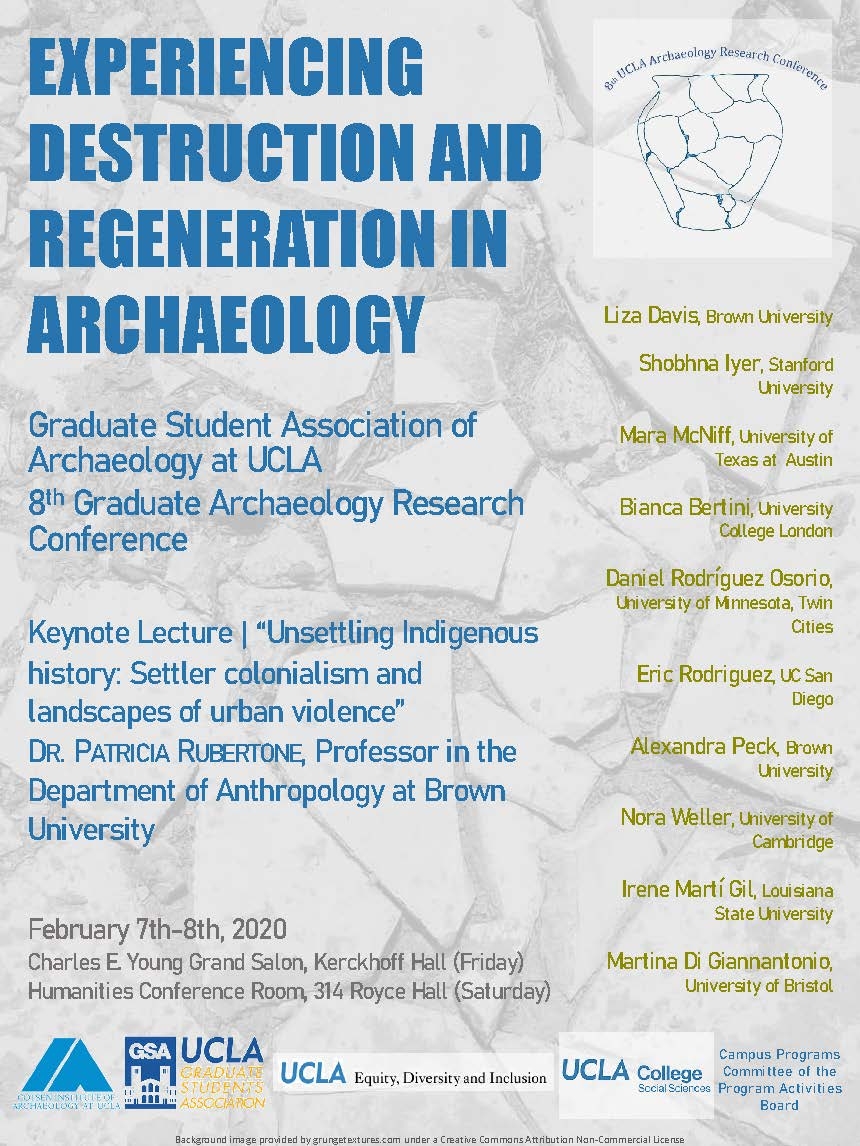 Speakers will discuss the many contexts in which uncontrolled or deliberate destruction—as well as regeneration, reconstruction, and re-use—plays a part in the archaeological past and present. Destruction lies at the heart of archaeological inquiries, seen in every context from the collapse of civilizations to the deliberate breaking of ceramics in ritual settings. Destruction of archaeological remains also occurs in the present through the neglect or eradication of material heritage for economic, sociopolitical or environmental reasons. Simultaneously, reconstruction and regeneration penetrate every aspect of archaeology—seen in current heritage management practices as well as in the material traces of ancient and modern peoples’ efforts at recovery, rebuilding and re-use.
Speakers will discuss the many contexts in which uncontrolled or deliberate destruction—as well as regeneration, reconstruction, and re-use—plays a part in the archaeological past and present. Destruction lies at the heart of archaeological inquiries, seen in every context from the collapse of civilizations to the deliberate breaking of ceramics in ritual settings. Destruction of archaeological remains also occurs in the present through the neglect or eradication of material heritage for economic, sociopolitical or environmental reasons. Simultaneously, reconstruction and regeneration penetrate every aspect of archaeology—seen in current heritage management practices as well as in the material traces of ancient and modern peoples’ efforts at recovery, rebuilding and re-use.
Speakers are encouraged to approach this topic from an experiential perspective, as moments of destruction and reconstruction or regeneration provide communal sensorial experiences, producing and reproducing social memory and shared identities. Archaeology, as a discipline rooted in materiality, can access these senses at their most basic level. Exploring such experiences of destruction and regeneration allows us to better understand the mindsets of past and present peoples alike as they destroyed, rebuilt and remembered.
Keynote speaker Dr. Patricia Rubertone, Professor of Anthropology at Brown University, will address instances of destruction and regeneration through the intersecting lenses of archaeology, history and ethnography. She will discuss commemoration and erasure of Native American monuments in New England in the context of colonialism, as well as the implications of documentary genocide and urban renewal for recovering indigenous pasts.
Please RSVP by February 3rd here.
Email any questions to archaeogradcon@ioa.ucla.edu. The call for papers can be downloaded here.
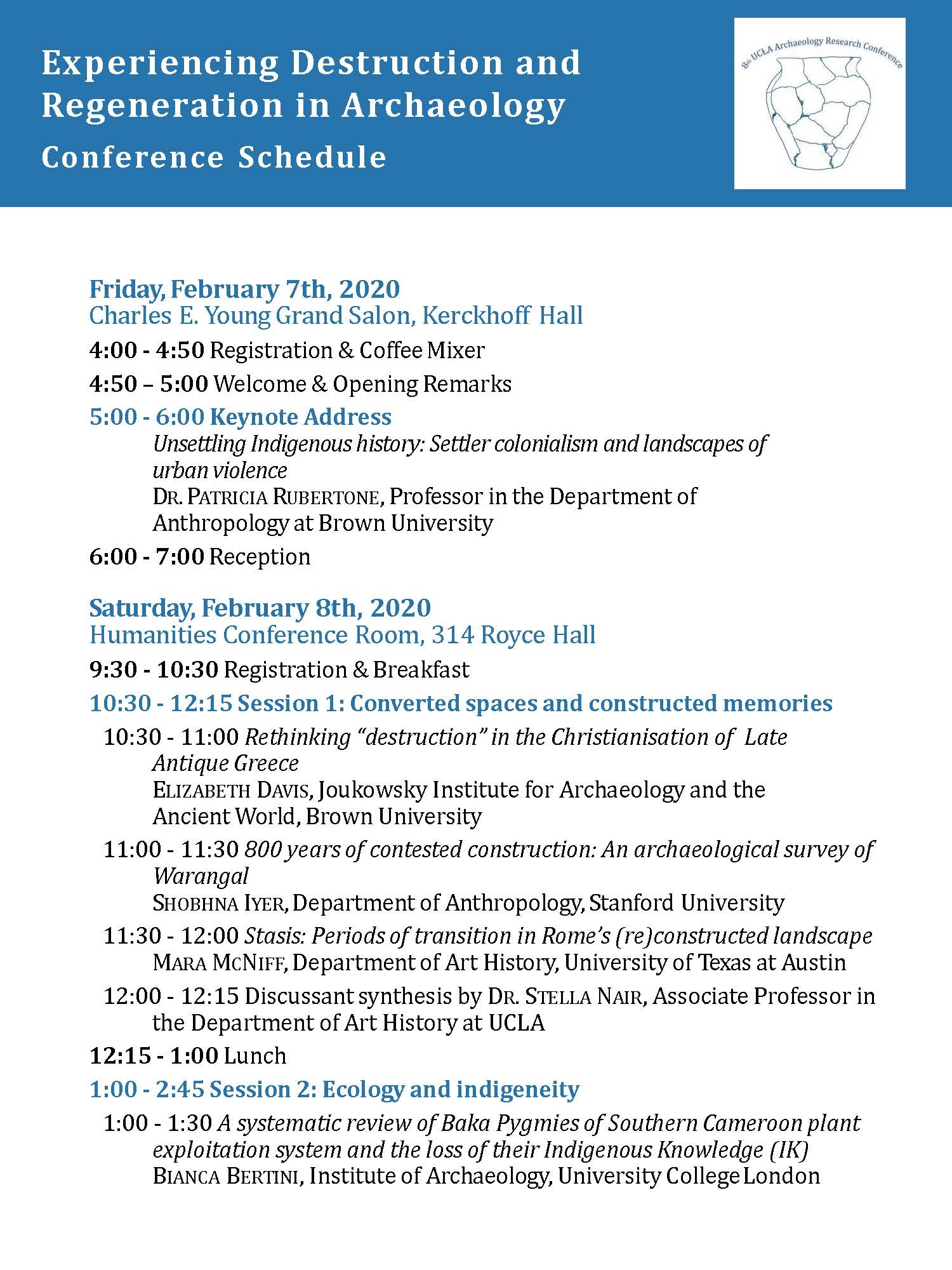

Contact Conference organizers
Email archaeogradcon@ioa.ucla.edu
Phone
SPEAKER: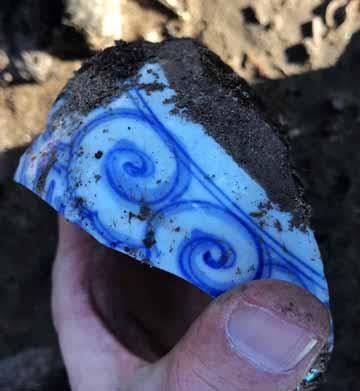
James E. Snead
Professor
Department of Anthropology
Cal State Northridge
ABSTACT:
Historical archaeology in the western United States has traditionally focused on either the colonial-era "missions" or 19th century mining sites in remote locations. Recently, however, historical archaeology itself has undergone a major conceptual shift, emphasizing the ways that the study of material culture can shed light on a wide range of historical topics dating to relatively recent times. These often bear on contemporary social issues, including ethnicity, identity, labor, and heritage. The diverse communities of Los Angeles present a remarkable template for such research: this talk will describe current scholarship at CSUN focusing on specific "lost narratives" of the city's post-1850s inhabitants as examined through archaeology. Particular emphasis will be placed on the dynamics of "community engagement" that are the organizational center of these efforts.
Contact Sumiji Takahashi
Email sutakahashi@ioa.ucla.edu
Phone 310-825-4169
Cotsen faculty Jason De León will be a guest on the podcast "Armchair Expert with Dax Shepard" on February 1, 2020. The UCLA Department of Anthropology is hosting a live taping of the podcast at 6:00pm in Korn Convocation Hall at UCLA.
De León will also be speaking on February 11th as part of the Archaeology 50th Anniversary Lecture Series.
Dax Shepard
BA '00, Anthropology
in conversation with
Jason De León
Professor
UCLA Department of Anthropology
UCLA Department of Chicana and Chicano Studies
![]()
Saturday, February 1, 2020
6:00 p.m.
Korn Convocation Hall
UCLA

Registration required.
Seating is first come, first served and is not guaranteed.
Self-pay parking available in Structure 4
About Armchair Expert:
Armchair Expert is a weekly podcast hosted by American actor, director, and writer Dax Shepard and Emmy-nominated Monica Padman. Each podcast features Shepard and Padman interviewing celebrities as well as journalists and academics about "the messiness of being human". Click here to learn more about Armchair Expert.
Contact
Phone
The Old Kiyyangan Story, an anthropological film based on oral histories and archaeological excavations at the Old Kiyyangan Village, Ifugao, Philippines, will be presented January 31 at 5pm in the Anthropology Reading Room. In addition to the film screening, there will be a research presentation and Q & A with co-screenwriter and Associate Professor of Anthropology, Dr. Stephen Acabado. Acabado is a core faculty member of the Cotsen Institute of Archaeology. The event is free and open to the public.
A trailer for the film can be viewed here.
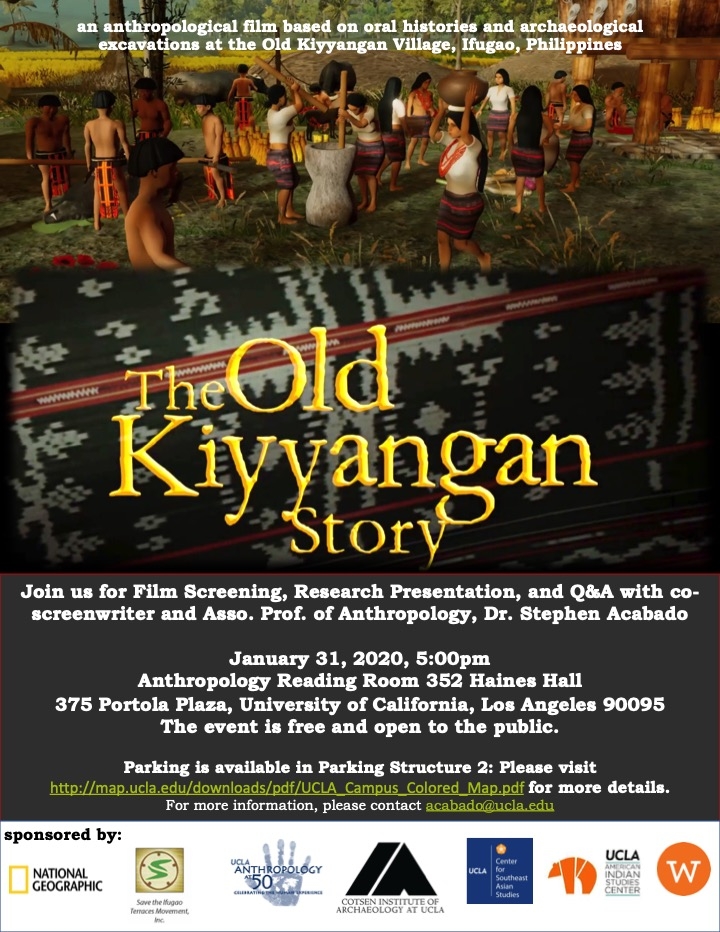
Contact Stephen Acabado
Phone
SPEAKER: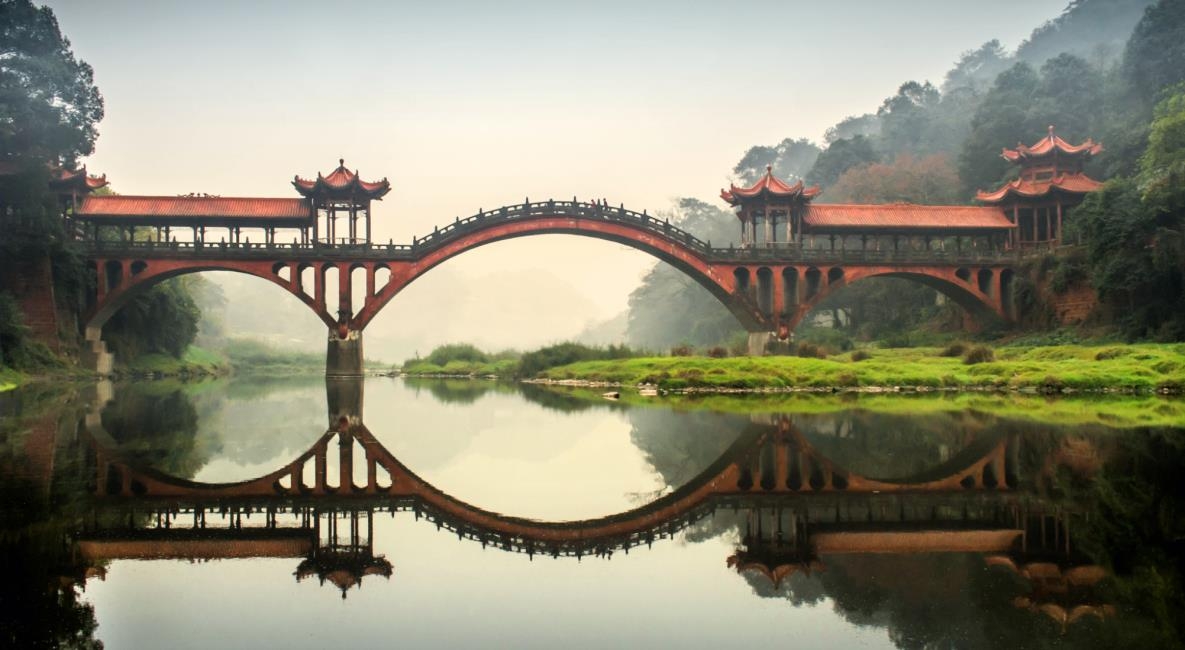
Dr. Ryan Nichols
Associate Professor
Dept. of Philosophy
Cal State Fullerton
ABSTRACT:
The purpose of this paper is to preliminarily explain the initial conditions and key forces from the Paleolithic, Neolithic, and pre-Imperial periods that contributed to distinctive features of subsequent Chinese culture, and to do so in accordance with an explicit model of cultural transmission. The paper opens with discussion of a small suite of genes supporting neurotransmitter function, genes that were selected in Continental East Asians. Second, Paleolithic climate, rainfall, plant domesticates, and physical ecological factors, principally of the Yellow River and North China Plain area, are reviewed with respect to their influence on early settlers and their social ecology. This focus fuels the third section too. In it I discuss the kinship structure, political organization, warfare, and religion of these Neolithic settlers. Fourth, the onset of cultural trends during the Shang and Zhou periods are discussed in terms of the initial conditions described above. By-products of this discussion include the identification of lacunae in a well-known model of cultural transmission, and the provisioning of the cultural evolutionary research community with a template, a draft template, for analytical application of theory to a historical population that explicitly considers Paleolithic and Neolithic genetic selection.
Contact Sumiji Takahashi
Email sutakahashi@ioa.ucla.edu
Phone 310-825-4169
Dr. Sonia Zarrillo will be presenting on "New Approaches to Tracing Cacao's Dispersal from the Amazon Basin” on January 23rd at 5pm in the Cotsen Seminar Room (A222). This event was sponsored by the Andean Working Group.
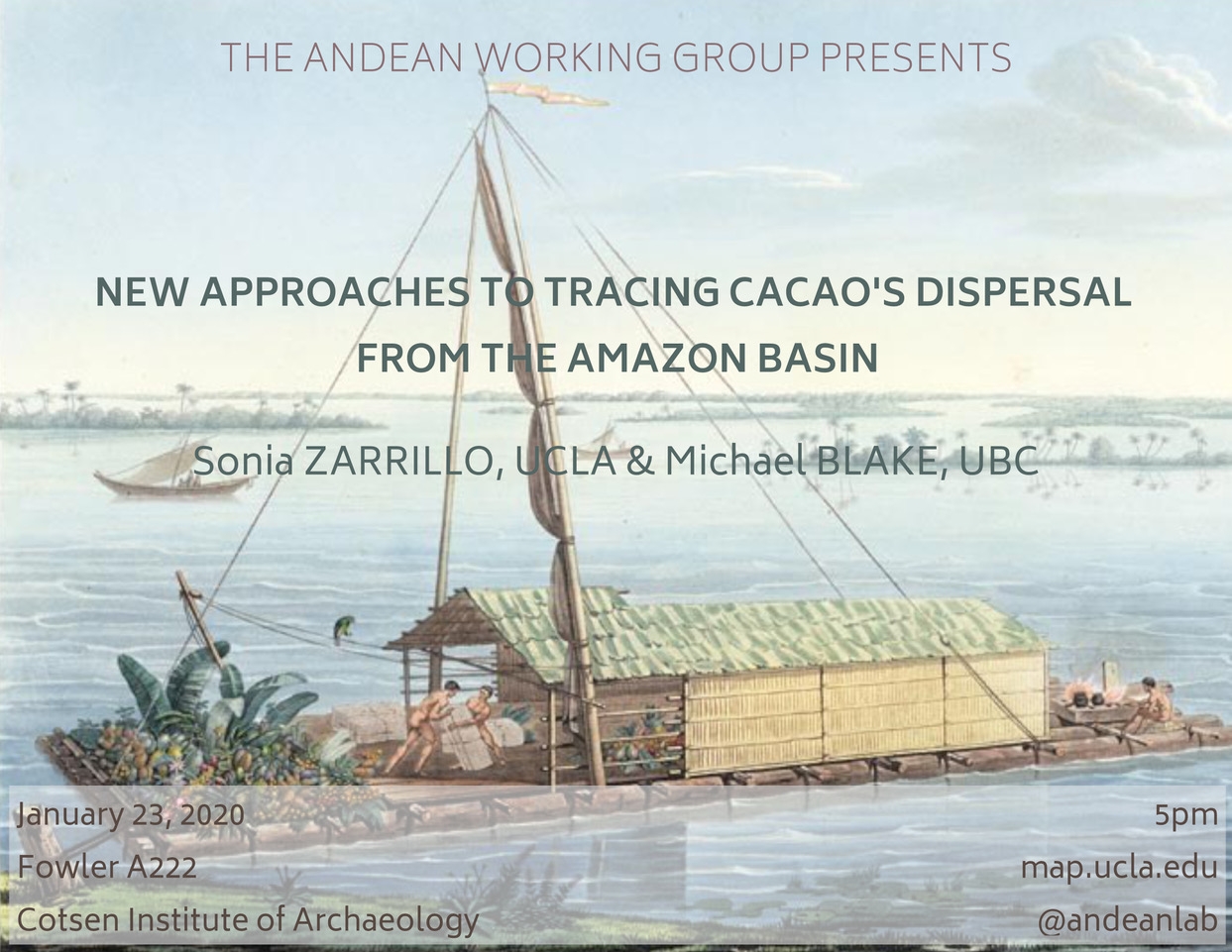
Contact Louise Deglin
Phone
SPEAKER: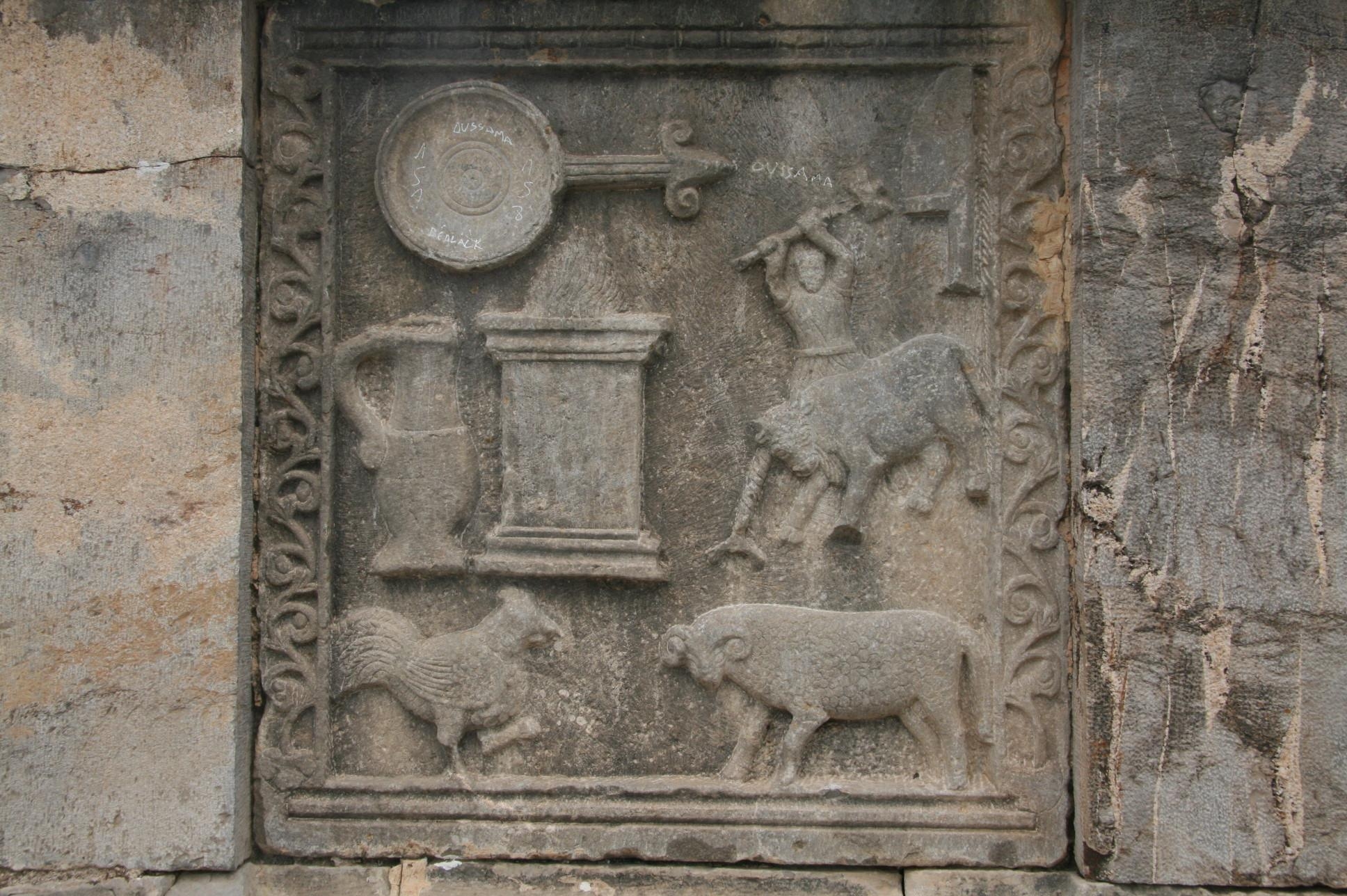
Dr. Claudia Moser
Associate Professor
Dept. of History of Art & Architecture
UC Santa Barbara
ABSTRACT:
This talk explores what we can learn about Roman Republican sacrifice through the study of the material remains of sacrifice and the architectural settings in which the ritual occurs. I will argue that by examining the material record of sacrifice --the aniconic altars of the Republican period, their relations to the natural and built landscape, and the accompanying archaeological evidence of the ritual --we can form a comprehensive view of the procedure of sacrificial ritual, detailing aspects of the practice that might be absent from or inconsistent with what is found in images or texts. In this talk, I will integrate various types of evidence (topographic and architectural evidence, zooarchaeological material, and votive crafted goods) to reveal a sacrifice that is intricately linked to the sanctuary in which it is enacted, a sacrifice that is local and site-specific.
Contact Sumiji Takahashi
Email sutakahashi@ioa.ucla.edu
Phone 310-825-4169
Fowler Curator of Archaeology Wendy Giddens Teeter will discuss the importance of the collaborative web-based project Mapping Indigenous Los Angeles and her experiences working with the Tongva and indigenous communities to forefront the multiple historical layers of Los Angeles. She will also speak about national and international repatriation efforts as UCLA’s Native American Graves Protection and Repatriation Act (NAGPRA) Coordinator, which has helped Native American tribes regain their ancestors and cultural heritage as well as provide a platform to share their voices in online exhibitions, such as Carrying our Ancestors Home.
For more information, please visit: https://www.fowler.ucla.edu/events/lecture-by-wendy-teeter-mapping-indig...
Contact
Phone
SPEAKER: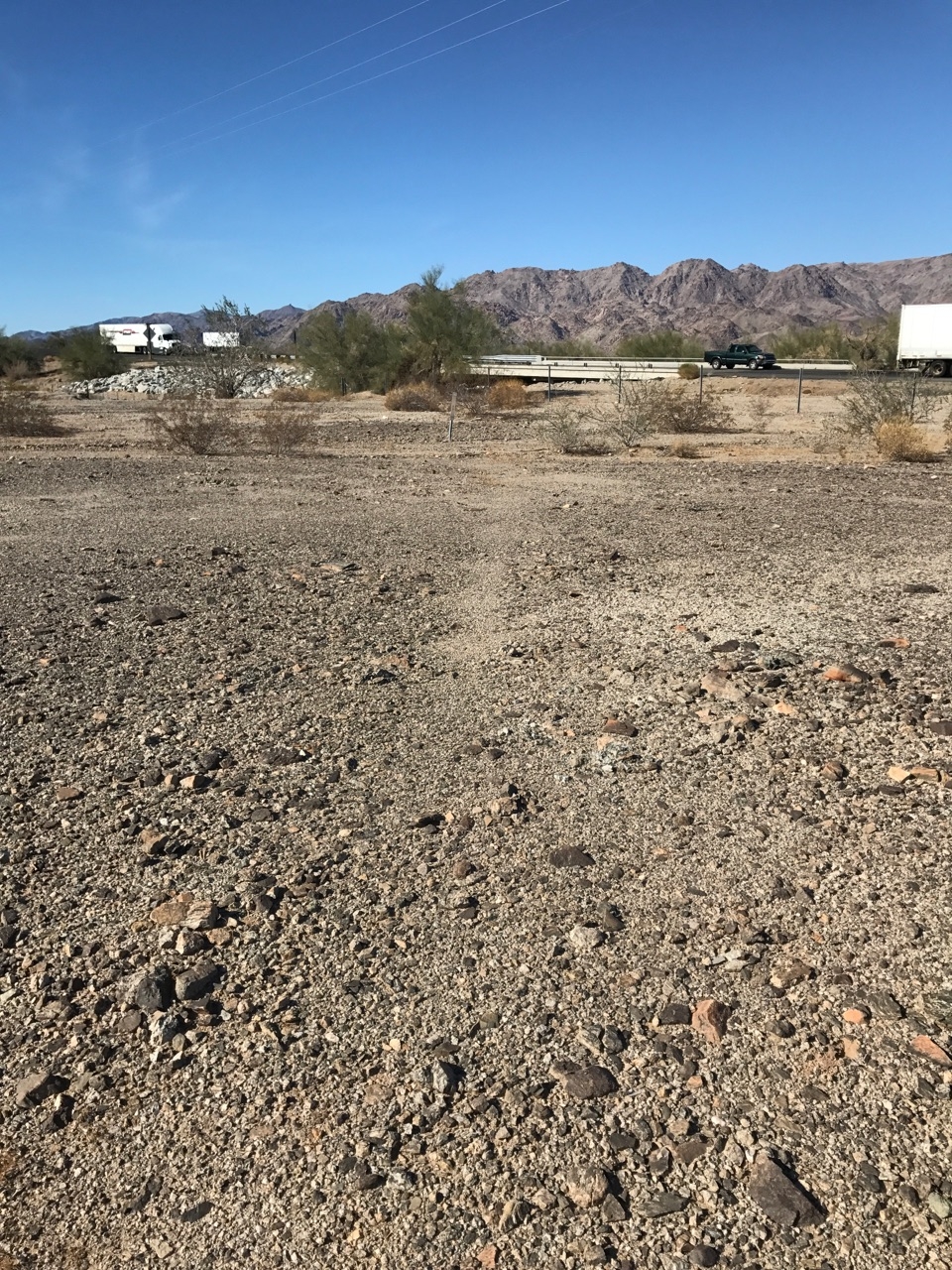
George D. Everson
Adjunct Professor
Dept. of Anthropology
Mt. San Jacinto College
ABSTRACT:
Cultural Resource Management (CRM) has become a mainstay in our society for professional archaeologists and architectural historians. The California Department of Transportation (more commonly known as Caltrans) has their own staff of professionals to ensure that highway projects comply with applicable environmental laws. Specifically, Caltrans has professionals on staff to ensure we meet the standards of Section 106 of the national Historic Preservation Act.
Contact Sumiji Takahashi
Email sutakahashi@ioa.ucla.edu
Phone 310-825-4169
The UCLA/Getty Conservation Program presents “The man who can read the unreadable,” computer scientist and professor W. Brent Seales, the first speaker in the 50th Anniversary Lecture Series. 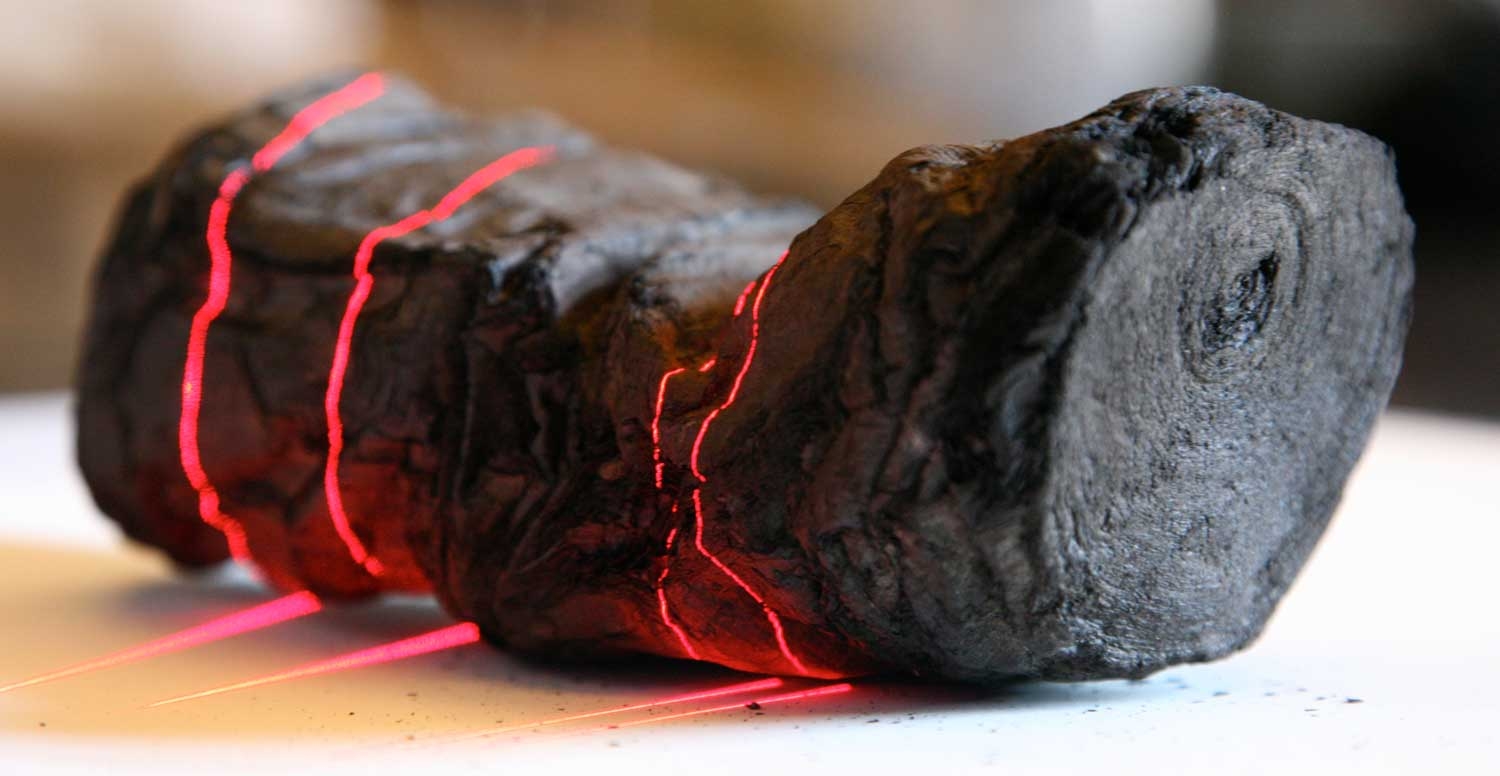 Currently a Getty Conservation Institute Scholar, Seales and his team have been key to revealing texts on papyri that are too fragile to unroll, such as Homers “Iliad” and the Dead Sea Scrolls. The recipient of a $2 million grant from The Andrew W. Mellon Foundation, Seales will discuss how technological progress over the past ten years has led to the promise of “virtual unwrapping” for reading the “invisible library” of scrolls found at Herculaneum; papyri that were buried and burned in the eruption of Mount Vesuvius in 70 CE.
Currently a Getty Conservation Institute Scholar, Seales and his team have been key to revealing texts on papyri that are too fragile to unroll, such as Homers “Iliad” and the Dead Sea Scrolls. The recipient of a $2 million grant from The Andrew W. Mellon Foundation, Seales will discuss how technological progress over the past ten years has led to the promise of “virtual unwrapping” for reading the “invisible library” of scrolls found at Herculaneum; papyri that were buried and burned in the eruption of Mount Vesuvius in 70 CE.
Reservations requested. Click here to RSVP by January 8. For more information call 310-825-4004.
Friends of the Cotsen Institute are invited to a private reception with Dr. Seales at 6pm. To learn more about the Friends visit their page or contact Michelle Jacobson at mjacobson@ioa.ucla.edu.
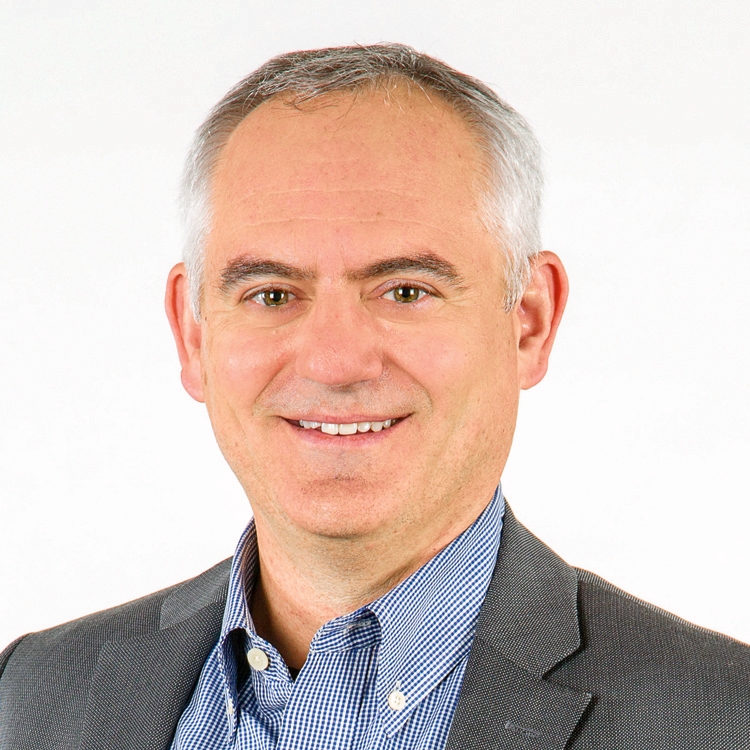 Seales is Professor and Chairman of the Department of Computer Science at the University of Kentucky. His research applies data science and computer vision to challenges in the digital restoration and visualization of antiquities. In 2012-13, he was a Google Visiting Scientist in Paris, where he continued work on the “virtual unwrapping” of the Herculaneum scrolls. In 2015, Seales and his research team identified the oldest known Hebrew copy of the book of Leviticus (other than the Dead Sea Scrolls), carbon dated to the third century C.E. The reading of the text from within the damaged scroll has been hailed as one of the most significant discoveries in biblical archaeology of the past decade.
Seales is Professor and Chairman of the Department of Computer Science at the University of Kentucky. His research applies data science and computer vision to challenges in the digital restoration and visualization of antiquities. In 2012-13, he was a Google Visiting Scientist in Paris, where he continued work on the “virtual unwrapping” of the Herculaneum scrolls. In 2015, Seales and his research team identified the oldest known Hebrew copy of the book of Leviticus (other than the Dead Sea Scrolls), carbon dated to the third century C.E. The reading of the text from within the damaged scroll has been hailed as one of the most significant discoveries in biblical archaeology of the past decade.
Contact Michelle Jacobson
Email mjacobson@ioa.ucla.edu
Phone 310-825-4004
- ‹ previous
- 24 of 50
- next ›


